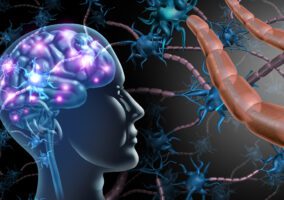Fibromyalgia Syndrome Simplified
Fibromyalgia has been “trash can” labeled, just as another syndrome, simply because no one is sure what causes fibromyalgia.
It’s not any easy task; fibromyalgia represents a whole barrage of symptoms with groups or clusters of symptoms, which makes it hard to properly diagnose, treat or cure.
Fibromyalgia has been generally thought of as a type of “rheumatic” or inflammatory pain disorder, but instead of involving the joints it’s characterized by a painful tenderness around tendons, surrounding tissue and muscles.
Later in this article I will reveal how some leading researchers now suspect fibromyalgia may be more of a neurological disorder than inflammatory.
How Is Fibromyalgia Classified?
First, let’s look at the diagnostic criteria established more than two decades ago by the American College of Rheumatology (ACR) in 1990.
According to ACR guidelines, fibromyalgia symptoms must represent wide spread chronic pain in at least 11 of 18 defined “tender points” of the body.
Currently, these “tender points” are being reconsidered because after all these years of misdiagnosing people. Doctors have finally accepted the possibility that there is more to fibromyalgia then just inflammatory pain.
Other symptoms may include:
- Chronic fatigue
- Sleep disorders
- Mental issues
Fibromyalgia is like electricity: we can say we know a lot about it, but we still can’t explain exactly what it is.
The Adrenal Connection
.
Common Adrenal Fatigue symptoms are: *Cravings for sugar, *Cravings for salt on food when you eat, *Feel dehydrated and thirsty and require plenty of water, *Difficulty falling asleep at night, sleep lightly or wake early or often, *Difficulty relaxing, nervous, anxious or hyperactive, *Often spacey, or foggy thinking, even memory loss,* Lack willpower to accomplish, *General exhaustion,*Hormone imbalances, *Low libido,*Weight gain, especially in abdomen and waist area, *Losing muscle tone, *Sagging skin, dry, yellow or pale in color, *Hair starting to gray, thin out and become dry, *Lips losing their color,*Loss of appetite, *Anorexia, *Weight loss,*High blood sugar
Fibromyalgia can also be related to a decreased adrenal function or adrenal fatigue. There are a few other diseases that also have an adrenal system component, such as: chronic fatigue syndrome, alcoholism, ischemic heart disease, hypoglycemia, rheumatoid arthritis and recurrent respiratory infections.
I am mentioning this because it’s important to identify where fibromyalgia and other disease patterns overlap in the hope of finding better solutions than what are typically offered.
It’s also interesting to note that researchers have found circulatory abnormalities in as many as 30% of fibromyalgia patients in preliminary studies (3).
Here’s another interesting piece of research from the Journal of the American Medical Association (JAMA): they found a significant number of fibromyalgia patients had infectious microorganisms, many which are not detected by ordinary laboratory tests (4). According to current peer-review studies, recovery from fibromyalgia will not take place until these invaders are eliminated.
These invading microorganisms overburden metabolic systems, draining adrenal system resources. By supporting adrenal health while also cleansing the body of these infectious microorganisms, severe cases of fibromyalgia have recovered relatively quickly.
Sometimes, fibromyalgia symptoms will follow a weakened immune system triggered by an over burdened adrenal system, but sometimes the adrenal fatigue is triggered from the fibromyalgia.
NOTE: You can test for adrenal fatigue by taking a simple adrenal hormones saliva test for to help determine if it is indeed a factor.
Again, my goal here is to simplify the fibromyalgia science. The best way to do that is to cover all the bases, to give you a well-rounded picture, so you can then put the pieces of your health back together.
When The Drug Solution Is The Problem
As it stands, the FDA hasn’t sanctioned a cure for fibromyalgia, but there is some progress being made with drugs and especially with alternative therapies.
There’s been some experimentation using calcium blockers, NSAIDs (pain killers) and opioids to deaden the electrical fibromyalgia pain signals, but due to adverse side effects such as an increased hypersensitivity, research has moved on to other things.
One thing should be self-evident here: fibromyalgia is NOT a drug deficiency.
So, if you desire a cure you must go beyond just treating symptoms. Nothing will ever change if you’re only treating the symptoms — nothing ever changes at that level. To cure fibromyalgia you have to treat the “cause” of it; that’s the ONLY place you will be able to change anything.
Other studies have revealed promising results from using regular exercise, positive thinking and nutritional education to treat fibromyalgia (5,6,7,8,9,10,11).
As you can see, we do need to promote more of these kinds of “natural healing cure results” instead of wasting time and money inventing more designer drugs to experiment on mice and men with.
Fibromyalgia affects more than 11,000,000 people just in the United States and carries an annual direct health care cost of more than $20 BILLION.
Never mind that fibromyalgia is one of the leading causes of disability in the world and ignoring the inarguable evidence of several natural healing cures, neither the FDA nor European Medicines Agency (EMEA) will consider approving anything, unless it’s produced by the “drug industry” . . . which is tragic.
That’s why few people know about the natural remedies for fibromyalgia.
It could take decades to finish testing all the competitive drug trials fighting for shelf space, which is a classic example of how the solution is often the problem.
The longer people keep squandering precious time and money looking for the next “magic pill,” the more they’ll delay discovering the amazing benefits of using more natural healing cure approaches.
A good health practitioner will help you find a “personalized approach” to help you heal yourself of fibromyalgia naturally.
A Medical Paradigm Shift
Ever since Dr. Graham first coined fibromyalgia as “fibrositis syndrome” in the 1950’s, it’s been assumed to be a rheumatological disorder (12).Recently, after studying biopsies of the 18 “tender points” some researchers have concluded there’s no reason to classify it as “rheumatic” fibromyalgia, because they didn’t find any physical abnormalities in the surrounding tissues.
This evidence, or lack of it, is convincing some doctors to re-classify fibromyalgia as a neurological disorder now. All this really means is, now fibromyalgia isn’t being treated as an inflammatory (rheumatoid) disease at all.
This may explain why nonsteroidal anti-inflammatory drugs (NSAIDS), calcium blockers and opioids have failed to affectively stop fibromyalgia symptoms.
This emerging technology has led researchers to take a closer look at how the sensory stimulation is processed through the Central Nervous System (CNS). Hopefully, this will help explain why the CNS is amplifying what should be non-painful stimulation into painful “tender points.”
As you already know, people suffering from fibromyalgia have lower pain thresh holds than normal (1,2).
Due to this new “180 degree shift” in thinking, the FDA has finally given approval for the first drug (Pregabalin/Lyrica) to treat centralized fibromyalgia pain. Pregabalin is a dual receptor uptake inhibitor effecting both serotonin and norepinephrine (13).
Pregabalin/Lyrical is from a class of drugs called Serotonin–norepinephrine reuptake inhibitors (SNRIs), which were originally designed for treating major depression, mood disorders and other neurological disorders.
SNRIs act upon and increase the levels of both neurotransmitters (serotonin and norepinephrine) in the brain. These neurotransmitters play a vital role in mood and cognitive function.
Some of the known adverse drug affects of taking SNRIs are:
- Loss of appetite
- Weight gain
- Insomnia
- Drowsiness
- Dizziness
- Fatigue
- Headache
- Blown pupil
- Vomiting
- Loss of libido
- Inability to climax
- Urinary retention
- Elevated blood pressure
- Anxiety
- Low blood pressure
- Mental fog
- Fever
- Blurry vision
- Swollen hands, legs and feet
- Blood vessel tumors (in mice)
Pregabalin/Lyrica has also been used to treat seizures and has been found to increase the risk of suicidal thoughts or behavior in about 1 in 500 people.
Please note: Some side effects for Pregabalin may not be reported. Always consult your doctor or healthcare specialist for medical advice. You may also report side effects to the FDA at http://www.fda.gov/medwatch/ or 1-800-FDA-1088 (1-800-332-1088). Once you start taking Pregabalin you are warned NOT to try and stop without medical supervision.
Hard to believe this is FDA approved for people suffering from fibromyalgia, but considering pain killers (NSAIDs), opioids and calcium blockers are only effective in covering up pain 30% of the time, I guess they had to try something else.
The Natural Pathway To Healing Fibromyalgia Pain
Now that you’ve seen a few studies supporting natural healing therapies, which can help restore adrenal system function, increase circulation and improve cognitive function, let’s go a little further down the rabbit hole to see what other “drug free” approaches we can find to help cure fibromyalgia pain.
Yoga
A new study from the Oregon Health and Science University shows practicing mind/body techniques like Yoga can reduce fibromyalgia symptoms.
Oregon researchers published their results in the November journal of the International Association for the Study of Pain (14).
The best way to restore function, improve mood and reduce fibromyalgia pain integrated an entire potpourri of ancient yoga techniques including:
- Postures
- Meditation
- Mindfulness
- Group discourse
- Breathing exercises
- Yogic pain-coping principles
To participate in the study, the volunteers had all been diagnosed with fibromyalgia using “the American College of Rheumatology criteria” for at least one year, plus all of them had already tried a stable regimen of some kind of drug therapy for at least three months.
The researchers also used physical tests to identify changes in “tender points” to measure the effectiveness of any Yogic pain-coping principles used.
Tai Chi
Since we know Yoga helps fibromyalgia sufferers recover better than drugs, it should be no surprise that Tai Chi would also show promise as a helpful therapy too (15).
For people who are not physically fit, Yoga and Tai Chi offer gentle and effective alternative to general exercise therapies.
After a particular single-blind, randomized, control trial comparing Tai Chi with an exercise intervention class, researchers found the tai Chi group had a significantly greater improvement than the control group.
Addressing The Cause Of Fibromyalgia Safely
One of the most important things you can do you to conquer your fibromyalgia is to eliminate energy suckers from your life. Based on the “Health and Wellness Ladder” model, the first cause of dis-ease is loss of cellular energy.
Once your cells lose their life energy, they fail to absorb nutrients and eliminate wastes properly, which leads to stress, inflammation and a host of other degenerative symptoms.
There’s plenty of science blaming the loss of muscle cell energy production (adenosine nucleotide metabolism/ATP) as the main cause of fibromyalgia symptoms (16).
In order to address the root cause of this “loss of cellular energy,” leading researchers have found success using a natural molecule already produced by the body called D-Ribose.
D-Ribose is a powerful energizing glyconutrient (cellular sugar), which helps in overcoming adrenal fatigue and cellular exhaustion.
D-Ribose plays a vital role in the production of cellular energy from carbohydrates, proteins, carbon dioxide, fats and water, also making it a key building block of Ribonucleic Acid (RNA). All glyconutrients like D-Ribose are renowned for helping to nurture optimal cell membrane health.
Further in-depth studies have confirmed supplementation with D-Ribose improves heart cell function and quality of life in people with congestive heart failure (17).
Understanding that your heart is pure muscle, you can easily imagine how using super sugars like D-Ribose may be the missing link to another natural healing cure for fibromyalgia and more (18,19).
CONCLUSION: The good news is you don’t need to ruin your health with toxic pain killers or dangerous prescription mood enhancers for neurological disorders, when all you really need is to start using simple exercise techniques, meditate, breathe deeply, eat wisely and supplement with trace amounts of D-Ribose to safely and easily start rising back up the “Health and Wellness Ladder.”
Recovering from your fibromyalgia is as simple as learning how to produce, store and optimize life energy at the cellular level. Mild exercise, lifestyle changes and food support supplementation is fastest road to recovering from many so-called “incurable” health issues.
Remember, there is always hope.




























